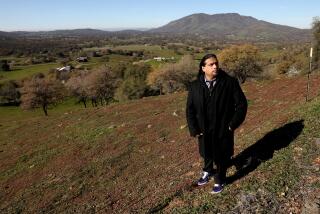Hip Change of Address Involves No Moving Vans : Communities: Work crews will simply shift Sherman Oaks boundary signs to include part of Van Nuys. And higher real estate prices will follow.
- Share via
Hundreds of homeowners in a 40-block area of the central San Fernando Valley this week became the latest to gain cachet and possibly cash by moving.
Sort of.
Midwife of change to these lucky homeowners was Los Angeles Councilman Zev Yaroslavsky, who informed them by letter that they are now residents of sylvan Sherman Oaks and no longer of industrial Van Nuys.
The final act in this mass community exodus will be performed not by a caravan of moving trucks but by city street crews who will simply move the boundary signs for Sherman Oaks farther north, from Magnolia to Burbank Boulevard, in the next 60 days--the latest episode in an outbreak of community name-changing in the San Fernando Valley.
The change, Yaroslavsky said in his letter to the homeowners released Thursday, would “clear up the confusion that has existed in your neighborhood.”
The symptoms of this confusion--although apparently not chronicled in the psychiatric literature--is that residents in the affected neighborhood didn’t know if they lived in Van Nuys or Sherman Oaks.
The area is called Van Nuys by the U.S. Postal Service, but historically it has had more in common with Sherman Oaks, the community to the south, Yaroslavksy said.
The new Sherman Oakies join a stream of Valley residents resolving identity crises by changing neighborhood names.
Recent years have seen the creation of West Hills, a spinoff of Canoga Park; Valley Village, a byproduct of North Hollywood; and North Hills, formerly part of Sepulveda.
What’s behind the latest name change?
Van Nuys has “an image that’s somewhat tarnished,” said Sol Taylor, leader of the community name-change movement, as he explained why local homeowners had pressed Yaroslavsky for an expanded Sherman Oaks.
“It’s got more problems in terms of urban congestion, immigration and older properties,” said Taylor, who rallied 90% of the homeowners in a month to sign petitions asking Yaroslavsky to back the name change.
Affected by the annexation are about 1,888 properties, which will now be worth 5% to 10% more, just because of the name change, Taylor said.
As a local real estate agent, Taylor said he hopes to reap a personal windfall of gratitude from local homeowners when they list their houses for sale. With the average house selling in the $300,000 range and picking up $15,000 to $30,000 in value due to the name change, “I expect to have some more clients,” Taylor said.
“It will definitely mean a substantial increase in value,” agreed Richard Close, president of the Sherman Oaks Homeowners Assn. But Close sees the Van Nuys-to-Sherman Oaks name-change campaign as silly in the final analysis.
“Boundary changes are becoming so political that community names hardly mean anything anymore,” Close said, even as he insisted that the Sherman Oaks immigrants will be welcomed by Sherman Oaks old-timers.
“But where’s it going to stop?” mused Close, who lives in the southern part of Sherman Oaks, near Mulholland Drive.
“The next thing you know, Sherman Oaks will be up to Saticoy. I don’t know. Maybe I should try to get Beverly Hills moved about 100 feet farther north and then my house will be in it.”
More to Read
Sign up for Essential California
The most important California stories and recommendations in your inbox every morning.
You may occasionally receive promotional content from the Los Angeles Times.













